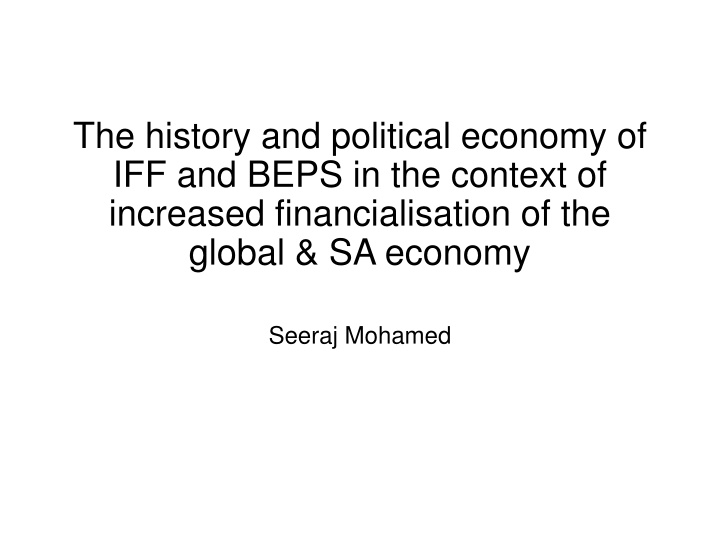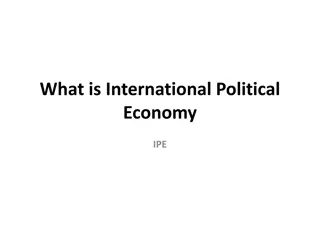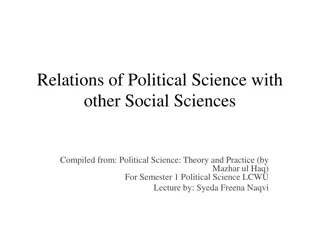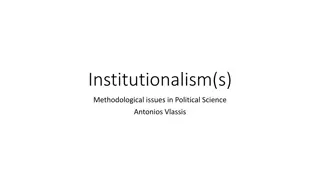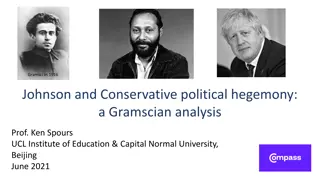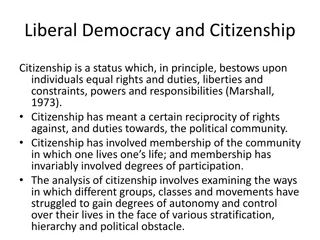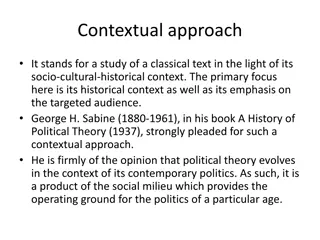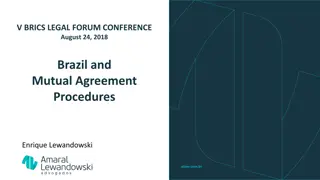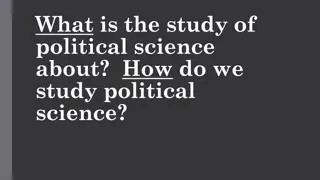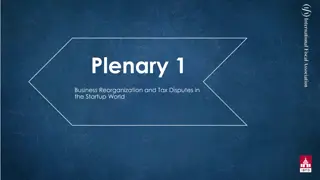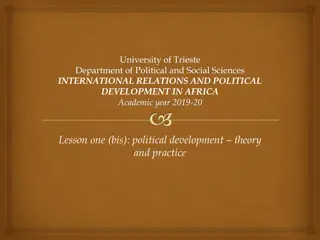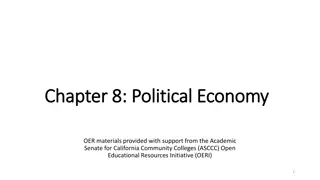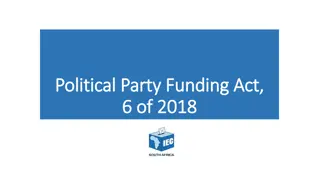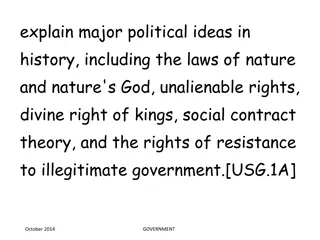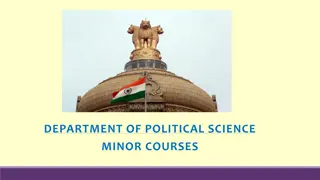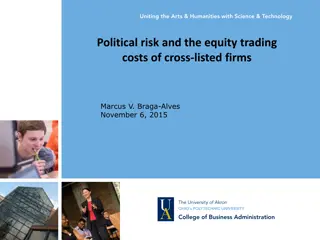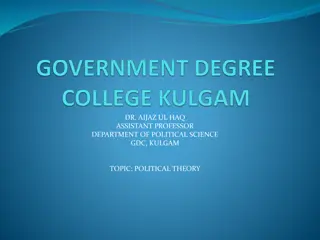Political Economy of IFF and BEPS in Global Economy
Neoliberalism's impact on financial system evolution, capital flight, and global financial architecture through historical events. Unpacking the dynamics of wealth accumulation, privilege, and elite interests in shaping economic policies.
Download Presentation

Please find below an Image/Link to download the presentation.
The content on the website is provided AS IS for your information and personal use only. It may not be sold, licensed, or shared on other websites without obtaining consent from the author.If you encounter any issues during the download, it is possible that the publisher has removed the file from their server.
You are allowed to download the files provided on this website for personal or commercial use, subject to the condition that they are used lawfully. All files are the property of their respective owners.
The content on the website is provided AS IS for your information and personal use only. It may not be sold, licensed, or shared on other websites without obtaining consent from the author.
E N D
Presentation Transcript
The history and political economy of IFF and BEPS in the context of increased financialisation of the global & SA economy Seeraj Mohamed
Neoliberalism and capital flight The logic of neoliberal ideology (well some of it ) The state enforces the idea that the market is sovereign and that the state should play as small a role as possible in the economy Businesses are treated like people and have the same rights The wealth of individuals is sacred and that should be able to do anything they want with it The state should not interfere in the cross-border movement of wealth The reality of neoliberalism is that it has given the elites and their business interests the ability to shape the rules in favour of their interests to the point where we all face several existential crises The elites (not a homogeneous group) know what is happening and some have put in place policies and actions to try to mitigate some of these crises There is a great amount of contestation within the elites and between elites and other classes However, the overwhelming response of the elites it to continue to accumulate wealth and privilege globally
How we got here (Hint: We don t always learn from our mistakes): The evolution of the global financial system and architecture (Not linear progress from regulation to liberalization & global integration) Aftermath of WWI and reparations Fin speculn and Great Depression End of gold standard New deal in USA Rise of fascism in Europe Breakdown of globalisation End of WWII and Bretton-Woods Coordn of global financial system Capital controls regulation of cross-border fin. flows Regulation of domestic finance (Glass- Steagal) Embedded liberalism & rapid economic growth: Welfare states, Keynesian policies, Full employment Rapid industrialn Innovation growth Productivity linked wages 1940s 1950s-1960s 1920s-1930s
How we got here ctd (pre-Covid-19) Wars: hot & cold, OPEC & 2 oil crises, Slowing innovation & prod. growth US econ slows to Germany & Japan Euro-dollar undermines cap controls Ends of fixed dollar-gold exch rate Stagflation Monetarist revolutn 1970s Reagan, Thatcher & neoliberalism Uncoord global fin system Washington consensus Volker int rate shock Competitive deregn of finance 1981 international debt crisis Black Monday crash 19/10/1987 Savings & loan crisis Liberaln of fin insts & instruments Huge M&A: global restr of corps & val chains Deregulation of institutl investors Huge growth in financial liquidity 1994 Mex peso crisis 1997 Asian fin crisis 1998 Russian fin crisis 2001 Dot.com crisis 2007/8 Global fin crisis Global financial system remains uncoordinated 1980s 1990s-2000s
South Africa - history and continued legacy: Oppression and exploitation Dispossession Minerals extraction and formation of a system of accumulation called the MEC Deindustrialisation and financialization Offshore listing and deregulation of deregulation of finance & cross-border flows Current context: Mass & growing unemployment & extraordinary inequality Neoliberal economic policies & austerity Low fixed investment and stagnant growth Highly internationalised, rent seeking big businesses Financialised financial and real sector High and volatile capital flows Mostly hot money flows not FDI High levels of capital flight
South African integration with global finance Bruce-Brand (2002) provides a history and overview of how South Africa has utilized exchange controls and liberalized. Main goals of the exchange controls in the past have been the preservation of savings and the management of inflows and outflows. The goals were: 1.To ensure the repatriation within the South African banking system of all currency acquired by residents of South Africa; 2.To prevent the loss of foreign currency resources through the transfer abroad of real or financial capital assets held in South Africa; and 3.To effectively control the movement into and out of South Africa of financial and real assets while at the same time not interfering with the efficient operation of the country s commercial, industrial and financial systems. Controls included: Blocked accounts for proceeds of asset sales by non-residents; Intro of dual currency in 1979 unified 1983 crisis 1985 and dual again until 1995
SA integration with global finance According to Bruce Brand in 1994 with reintegration of SA into global economy, the following sequence of liberalization planned: Abolish exchange controls on all current account transactions; Abolish exchange controls on non-residents; Gradually become more lenient in approval application for outward FDI; Allow institutional investors to acquire more foreign assets to diversify their portfolios; Progressively relax all other controls on resident individuals; Release emigrants blocked funds. Government has relaxed controls and enforcement of controls but at times, especially after the currency crisis in 2001 the SARB tightened up on controls and enforcement. Since 2002, as capital inflows recovered the Open Book was closed and controls were further relaxed.
Net financial flows as percentages of GDP 10% 8% 6% 4% 2% 0% 1990 1991 1992 1993 1994 1995 1996 1997 1998 1999 2000 2001 2002 2003 2004 2005 2006 2007 2008 2009 2010 2011 2012 2013 2014 2015 2016 2017 2018 -2% -4% -6% -8% Net direct investment Net financial derivatives Net portfolio investment Net other investment
Credit extension investment Credit extension by all monetary institutions as percentages of GDP 90% Bills discounted 80% Leasing finance 70% Loans granted under resale agreements 60% Net credit extended to the gov. sector 50% Investments 40% Loans and advances - Instalment sale credit 30% Mortgage advances 20% Other loans and advances 10% Loans and advances - Of which: To households 0% 9 Own calculations using SARB data
Private investment and credit Credit extension to the private sector and private business investment as percentages of GDP 2003 to 2008 2008 to 2013 2013 to 2019 100% 80% Priv. business Enterprises investment 60% 40% 4.2% -2.6% -0.7% 20% 0% Total credit to the private sector 2002 2000 2001 2003 2004 2005 2006 2007 2008 2009 2010 2011 2012 2013 2014 2015 2016 2017 2018 2019 19.7%-10.4% 3.4% Priv. bus. Enterprises investment Total credit to the private sector Total credit to private bus enterprises Credit to private bus. enterprises 6.2% -6.6% 7.6% Own calculations using SARB data Total credit extended to the private sector as a percentage of GDP increased 2.4% from 2013 to 2019 Total credit extended to private businesses as a percentage of GDP increased 7.6% from 2013 to 2019 Gross fixed capital formation by private businesses decreased by 0.7% Government debt is not crowding out private borrowing for investment (nor is household debt) 10
Financialisation and behaviour of NFCs Since 1994 composition of NFC financial acquisitions shifted from lending to other sectors & money assets to more diversification across a variety of financial assets, notably acquisition of ordinary shares, fixed interest securities and other assets. The asset side of the non-financial corporate balance sheet has shifted towards increasingly short-term assets. This increased acquisition of financial assets has been financed through the expansion of credit. The maturity mismatch between assets & liabilities is not conducive to long-term productive investments which drive capital accumulation. Consequently, we have seen the financing of the acquisition of (largely short-term) financial assets rather than fixed capital.
Net acquisition of financial assets and net capital formation of private businesses as percentages of GDP 14% 12% 10% 8% 6% 4% 2% 0% 1999 2018 1990 1991 1992 1993 1994 1995 Net acquisition of fin assets by corp bus enterprises Net capital formation - Private business enterprises 1996 1997 1998 2000 2001 2002 2003 2004 2005 2006 2007 2008 2009 2010 2011 2012 2013 2014 2015 2016 2017
Components of current account as percentages of GDP (2000-2018) 6% 4% 2% 0% 2000 2017 2001 2002 2003 2004 2005 2006 2007 2008 2009 2010 2011 2012 2013 2014 2015 2016 2018 -2% -4% -6% Trade balance Current transfers (net receipts +) Income receipts - income payments Net services recepts Balance on current account -8%
Allocation of finance left to institutional investors with short-term focus Dominance of institutional investors, power of shareholder value movement & focus on high short-term returns % of JSE market capitalization Type of owner, 2016 Foreign investors 38% Ownership through SA institutional investors 48% Retirement funds 24% Long-term insurance companies 5% Collective investment scheme 5% companies Investment managers 14% South African: Other investors 14%
The changed corporate landscape after the major corporate restructuring of the 1990s and early-2000s From 1999-2009, JSE-listed firms bought back R137 bn shares & R248 bn paid out in dividends (Wesson, 2015.) These estimates exclude giant corporations that moved their primary listings abroad, such as Anglo American Corporation Lead firms by sector on JSE have not changed much since 2000, i.e., the same large firms continue to dominate markets 50 companies constituted 86% of JSE s total mkt cap in 2017. 23 of top 50 companies on the JSE were cross listed in 2017. These accounted for 65% of the total market capitalization of the JSE. The remaining 27 companies accounted for 20% of the market capitalization of the JSE.
Disconnect between financial markets and real economy in SA JSE TOP 50 & SHARE OF CROSS LISTED COMPANIES IN TOP 50 IN 2017 SA operations small part of global operations, 2017 Naspers Richemont BAT South32 Anglo American PLC 66% 5,5% 8,0% 18,0% 10,0% 86% 14% 20% Top 50 7,0% Rest of JSE 23 of top 50 were cross listed Rest of top 50 (not cross listed)
The changed corporate landscape after the major corporate restructuring of the 1990s and early-2000s Two corporations SAB Miller (SAB) and British America Tobacco (BAT) alone accounted for 35% of total market cap of the top 50 companies. However, according to BAT s 2014 Annual Report, BAT had only 15% of its shares on the South African branch register. Many of the cross listed companies in the top 50 on the JSE have much of their actual operations outside of South Africa. South African operations were small compared to the entire company: Naspers 5.5%, Richemont 8%, BAT 18%, South32 10%, and Anglo American Plc 7%.
